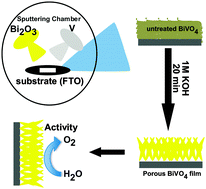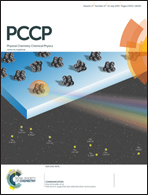Chemically induced porosity on BiVO4 films produced by double magnetron sputtering to enhance the photo-electrochemical response†
Abstract
Double magnetron sputtering (DMS) is an efficient system that is well known because of its precise control of the thin film synthesizing process over any kind of substrate. Here, DMS has been adopted to synthesize BiVO4 films over a conducting substrate (FTO), using metallic vanadium and ceramic Bi2O3 targets simultaneously. The films were characterized using different techniques, such as X-ray diffraction (XRD), UV-Vis spectroscopy, Raman spectroscopy, X-ray photoelectron spectroscopy (XPS), field emission scanning electron microscopy (FESEM) and profilometry. The photo-electrochemical analysis was performed using linear scan voltammetry, chronoamperometry and electrochemical impedance spectroscopy (EIS) under the illumination of simulated solar light at 1 Sun. The photocurrent density of the sputtered BiVO4 thin films could be improved from 0.01 mA cm−2 to 1.19 mA cm−2 at 1.23 V vs. RHE by chemical treatment using potassium hydroxide (KOH). The effect of KOH was the removal of impurities from the grain boundaries, leading to a more porous structure and more pure crystalline monoclinic BiVO4 particles. Such variations in the microstructure as well as the improvement of the charge transfer properties of the BiVO4 film after the KOH treatment were confirmed and studied in depth by EIS analysis.


 Please wait while we load your content...
Please wait while we load your content...